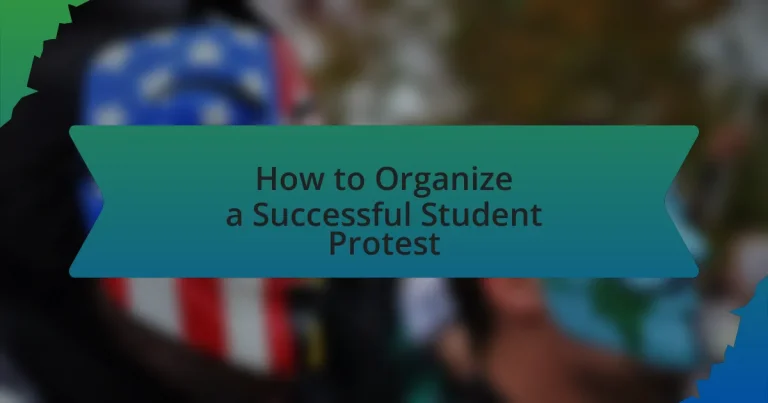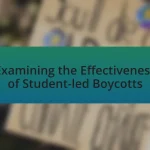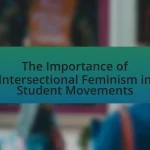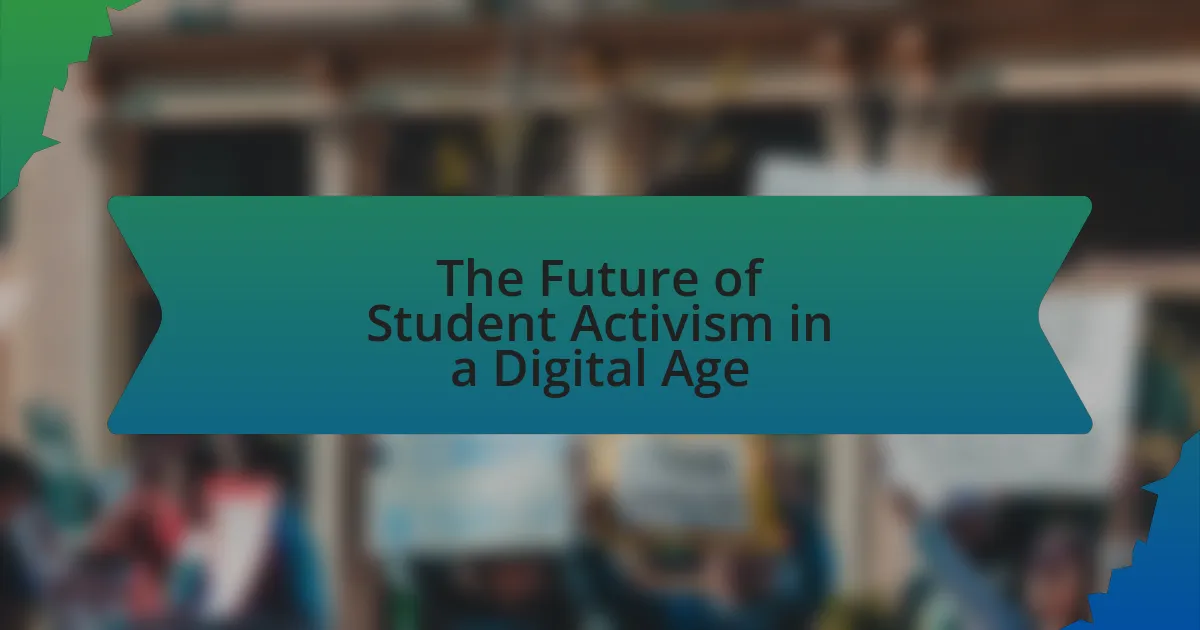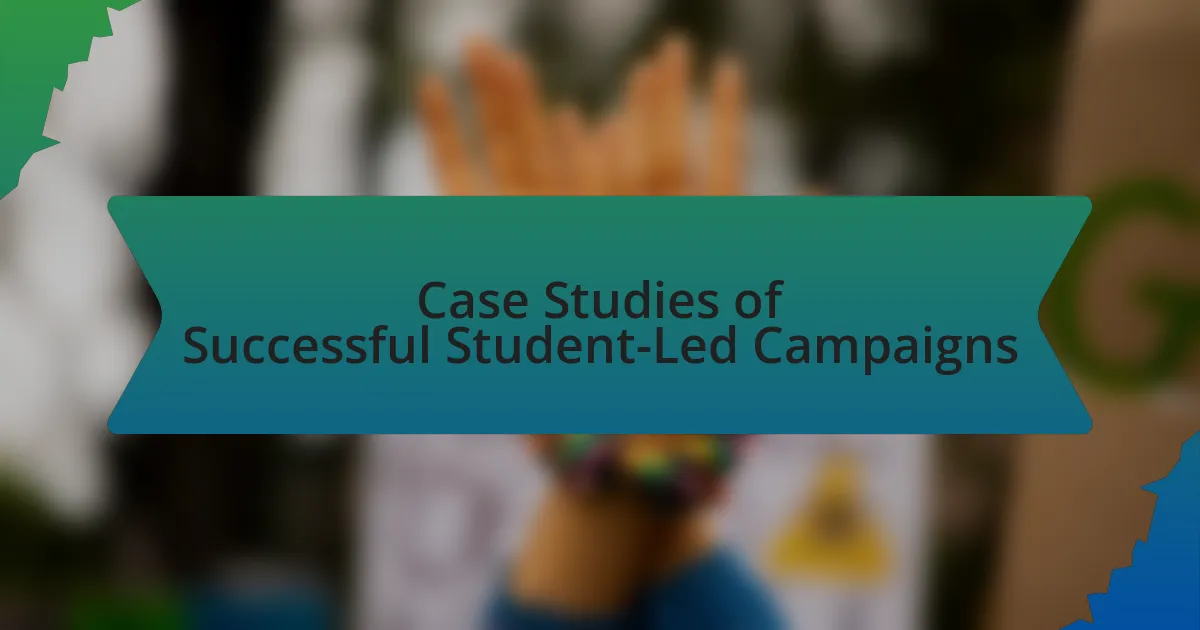The article focuses on the essential elements for organizing a successful student protest, emphasizing the importance of clear objectives, effective communication, strategic planning, participant mobilization, and adherence to legal guidelines. It outlines how to define protest goals, address specific issues affecting students, and the significance of building coalitions for broader support. Additionally, the article discusses logistical considerations, safety measures, and strategies for maintaining engagement and momentum during the protest. It concludes with best practices for executing the event and evaluating its success, while highlighting common pitfalls to avoid in the organizing process.
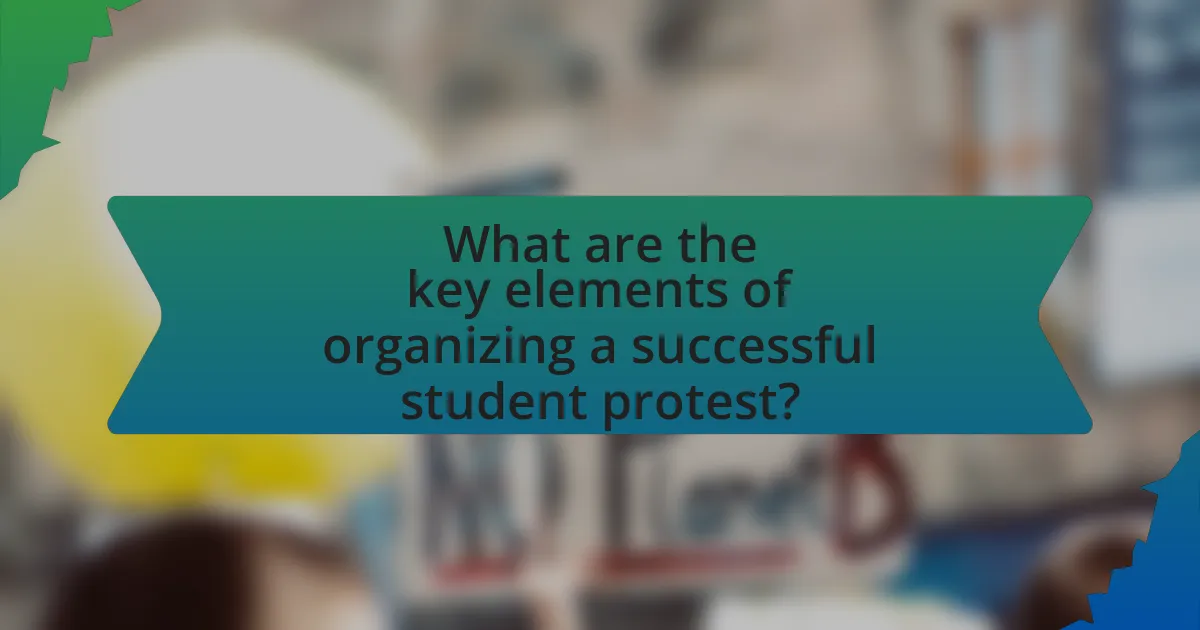
What are the key elements of organizing a successful student protest?
The key elements of organizing a successful student protest include clear objectives, effective communication, strategic planning, mobilization of participants, and adherence to legal guidelines. Clear objectives define the purpose of the protest, ensuring that participants understand the issues at stake, such as advocating for policy changes or raising awareness about social injustices. Effective communication involves utilizing social media, flyers, and word-of-mouth to inform and engage potential participants, as seen in the 2018 March for Our Lives, which effectively mobilized students nationwide. Strategic planning encompasses logistics such as location, timing, and necessary permits, which are crucial for ensuring the protest runs smoothly and safely. Mobilization of participants requires outreach to diverse student groups to foster inclusivity and solidarity, enhancing the protest’s impact. Lastly, adherence to legal guidelines, including obtaining permits and understanding local laws, is essential to avoid legal repercussions and ensure the protest’s legitimacy.
How do you define the goals of the protest?
The goals of the protest are defined as the specific objectives that participants aim to achieve through collective action. These objectives often include raising awareness about a particular issue, demanding policy changes, or expressing dissent against perceived injustices. For instance, the 2018 March for Our Lives protest aimed to advocate for gun control legislation following school shootings, highlighting the urgent need for legislative reform. This demonstrates that clearly defined goals can mobilize participants and attract public attention, ultimately influencing decision-makers.
What specific issues should the protest address?
The protest should address issues such as tuition fees, inadequate mental health resources, and lack of representation in decision-making processes. These issues directly impact students’ financial stability, well-being, and ability to influence policies affecting their education. For instance, a report by the College Board indicates that average tuition and fees at public four-year institutions have increased by 31% over the past decade, highlighting the financial burden on students. Additionally, a survey by the American College Health Association found that 63% of college students felt overwhelming anxiety, underscoring the need for improved mental health services. Lastly, the lack of student representation in university governance can lead to policies that do not reflect the needs and concerns of the student body, as evidenced by numerous student-led initiatives advocating for greater involvement in administrative decisions.
How can clear objectives enhance protest effectiveness?
Clear objectives enhance protest effectiveness by providing a focused direction for participants, which increases engagement and clarity of purpose. When protesters understand the specific goals, such as policy changes or raising awareness about an issue, they can tailor their messages and actions accordingly. Research indicates that movements with well-defined objectives, like the Civil Rights Movement, achieved significant legislative changes, demonstrating that clarity in goals can lead to tangible outcomes. This focus not only mobilizes participants but also attracts media attention and public support, amplifying the protest’s impact.
What role does planning play in a successful protest?
Planning is crucial for a successful protest as it ensures clear objectives, effective resource allocation, and strategic coordination among participants. A well-structured plan allows organizers to define the protest’s goals, identify key messages, and determine the best methods for communication and outreach. For instance, the 2018 March for Our Lives protest, organized by students advocating for gun control, exemplified effective planning through its detailed logistics, including route mapping, speaker coordination, and media engagement, which contributed to its widespread impact and visibility.
How do you create a timeline for the protest?
To create a timeline for the protest, first identify key dates and milestones relevant to the event, such as planning meetings, promotional activities, and the protest date itself. Next, outline specific tasks that need to be completed by each date, including securing permits, organizing transportation, and coordinating speakers. For example, if the protest is scheduled for April 15, ensure that permits are obtained by March 1, promotional materials are distributed by March 15, and a final meeting is held on April 10 to confirm logistics. This structured approach ensures that all necessary preparations are made in a timely manner, facilitating a successful protest.
What logistical considerations must be taken into account?
Logistical considerations for organizing a successful student protest include securing permits, determining the location, coordinating transportation, and ensuring safety measures. Securing permits is essential to comply with local laws and avoid legal issues, as many cities require official permission for public gatherings. The location must be accessible to participants and relevant to the cause, which can enhance visibility and impact. Coordinating transportation ensures that participants can arrive at the protest site efficiently, while safety measures, such as first aid stations and crowd control, are crucial to protect attendees and maintain order during the event.
Why is building a coalition important for a student protest?
Building a coalition is important for a student protest because it amplifies the collective voice and increases the impact of the movement. When students unite with various groups, such as faculty, community organizations, and other student bodies, they create a broader base of support that can mobilize more participants and resources. Historical examples, such as the 1960s civil rights movement, demonstrate that coalitions can lead to significant social change by combining diverse perspectives and strengths, thereby enhancing the legitimacy and visibility of the protest.
How can you identify potential allies and supporters?
To identify potential allies and supporters, assess individuals and groups that share similar goals or values related to the cause. Engaging in discussions, attending relevant events, and utilizing social media platforms can reveal those who express interest or support for the cause. Research indicates that collaboration with organizations that have a history of activism can enhance support networks; for instance, studies show that coalitions often increase the effectiveness of movements by pooling resources and amplifying messages.
What strategies can be used to engage diverse groups?
To engage diverse groups effectively, organizers should implement inclusive communication strategies, culturally relevant programming, and collaborative decision-making processes. Inclusive communication ensures that messages resonate across different cultural backgrounds, utilizing multiple languages and accessible formats to reach all participants. Culturally relevant programming involves incorporating diverse perspectives and experiences into the event’s activities, which can enhance participation and connection among attendees. Collaborative decision-making allows for input from various community members, fostering a sense of ownership and commitment to the cause. Research indicates that diverse groups are more likely to engage when they feel their voices are heard and valued, as demonstrated in studies on community organizing and social movements.
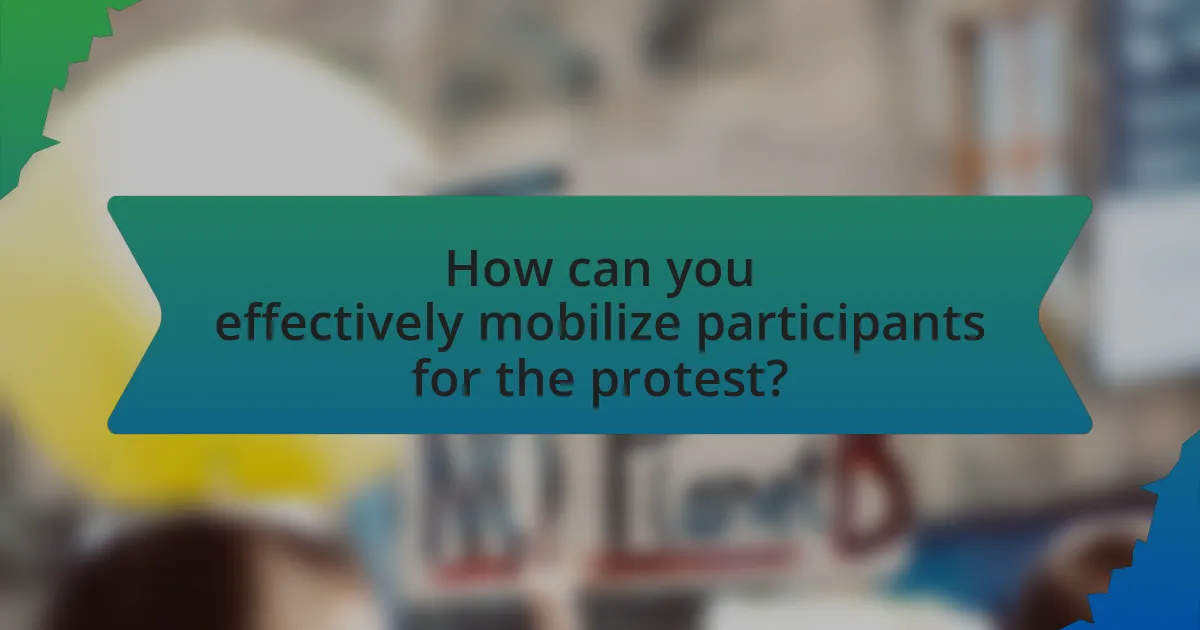
How can you effectively mobilize participants for the protest?
To effectively mobilize participants for the protest, utilize social media platforms to disseminate information and engage potential attendees. Research indicates that 79% of individuals aged 18-29 use social media, making it a powerful tool for outreach. Create compelling content that highlights the protest’s purpose, date, and location, and encourage sharing to expand reach. Additionally, collaborate with student organizations and community groups to leverage their networks, enhancing visibility and participation. Engaging messaging and clear calls to action can significantly increase turnout, as evidenced by successful movements that have harnessed these strategies.
What methods can be used to promote the protest?
To promote the protest, organizers can utilize social media campaigns, flyers, and community outreach. Social media platforms like Twitter, Facebook, and Instagram allow for rapid dissemination of information and engagement with a wider audience, as evidenced by the success of movements like Black Lives Matter, which effectively used these channels to mobilize supporters. Flyers can be distributed on campus and in local communities to raise awareness and provide details about the protest, while community outreach efforts, such as collaborating with local organizations, can help build a coalition of support. These methods have been proven effective in increasing participation and visibility for protests.
How can social media be leveraged for outreach?
Social media can be leveraged for outreach by creating targeted campaigns that engage specific audiences and disseminate information rapidly. Platforms like Facebook, Twitter, and Instagram allow organizers to share event details, mobilize supporters, and foster community engagement through interactive content. For instance, a study by Pew Research Center indicates that 69% of adults in the U.S. use social media, making it an effective tool for reaching a broad demographic. Additionally, using hashtags can amplify messages and connect with like-minded individuals, enhancing visibility and participation in student protests.
What traditional methods of communication are still effective?
Traditional methods of communication that are still effective include face-to-face conversations, printed flyers, and community meetings. Face-to-face conversations allow for immediate feedback and personal connection, which can enhance understanding and engagement. Printed flyers can effectively disseminate information in specific locations, ensuring that the message reaches the intended audience directly. Community meetings foster a sense of belonging and collective action, enabling participants to discuss issues openly and strategize together. These methods have been historically proven to mobilize groups, as seen in various successful protests where grassroots organizing relied on direct, personal communication to galvanize support and participation.
How do you ensure participant safety during the protest?
To ensure participant safety during the protest, organizers implement a comprehensive safety plan that includes risk assessment, communication strategies, and trained safety personnel. This plan involves identifying potential hazards, such as counter-protests or adverse weather conditions, and establishing clear communication channels among participants to relay important information quickly. Additionally, having designated safety marshals trained in conflict de-escalation and first aid can significantly enhance participant safety. Historical data shows that protests with organized safety measures experience fewer incidents of violence and injury, as evidenced by studies conducted by the American Civil Liberties Union, which highlight the effectiveness of proactive safety planning in large gatherings.
What measures should be taken to prepare for potential conflicts?
To prepare for potential conflicts during a student protest, organizers should establish clear communication channels and develop a comprehensive conflict management plan. Clear communication ensures that all participants understand the protest’s objectives, rules, and safety protocols, reducing the likelihood of misunderstandings that could escalate into conflicts. A conflict management plan should include strategies for de-escalation, designated mediators, and protocols for responding to confrontations, which are essential for maintaining order and safety. Historical examples, such as the 1960s civil rights protests, demonstrate that effective communication and planning can significantly mitigate conflict and enhance the protest’s impact.
How can you create a safe environment for all participants?
To create a safe environment for all participants in a student protest, establish clear guidelines and protocols that prioritize safety. This includes conducting risk assessments to identify potential hazards, ensuring adequate security measures are in place, and providing training for participants on how to respond to emergencies. Research indicates that well-organized protests with defined safety protocols can reduce incidents of violence and ensure participant well-being, as seen in studies by the American Psychological Association, which highlight the importance of preparation in mitigating risks during public demonstrations.
What strategies can enhance participant engagement during the protest?
To enhance participant engagement during a protest, organizers should implement interactive activities, such as workshops and discussions, that encourage active participation. Engaging participants through these methods fosters a sense of community and ownership over the cause, which has been shown to increase commitment and enthusiasm. Research indicates that protests with interactive elements can lead to higher levels of participant satisfaction and retention, as evidenced by studies conducted on social movements, such as the 2011 Occupy Wall Street protests, where engagement strategies significantly boosted turnout and involvement.
How can speeches and performances motivate attendees?
Speeches and performances can motivate attendees by inspiring emotional engagement and fostering a sense of community. When speakers share personal stories or compelling narratives, they create an emotional connection that resonates with the audience, making them feel understood and empowered. Research indicates that emotional appeals in speeches can significantly enhance persuasion and motivation, as demonstrated in studies on public speaking effectiveness. Additionally, performances, such as music or theater, can energize the crowd and reinforce the message, creating a memorable experience that encourages attendees to take action. For instance, during protests, songs that convey solidarity and resistance can unify participants and amplify their commitment to the cause.
What role does signage play in conveying messages?
Signage plays a crucial role in conveying messages during a student protest by providing clear, visual communication that captures attention and expresses key ideas. Effective signage can enhance the visibility of the protest’s objectives, as studies show that well-designed signs can increase message retention among onlookers by up to 70%. This visual medium allows protesters to succinctly articulate their demands, rally support, and create a unified identity, which is essential for mobilizing participants and garnering public interest.
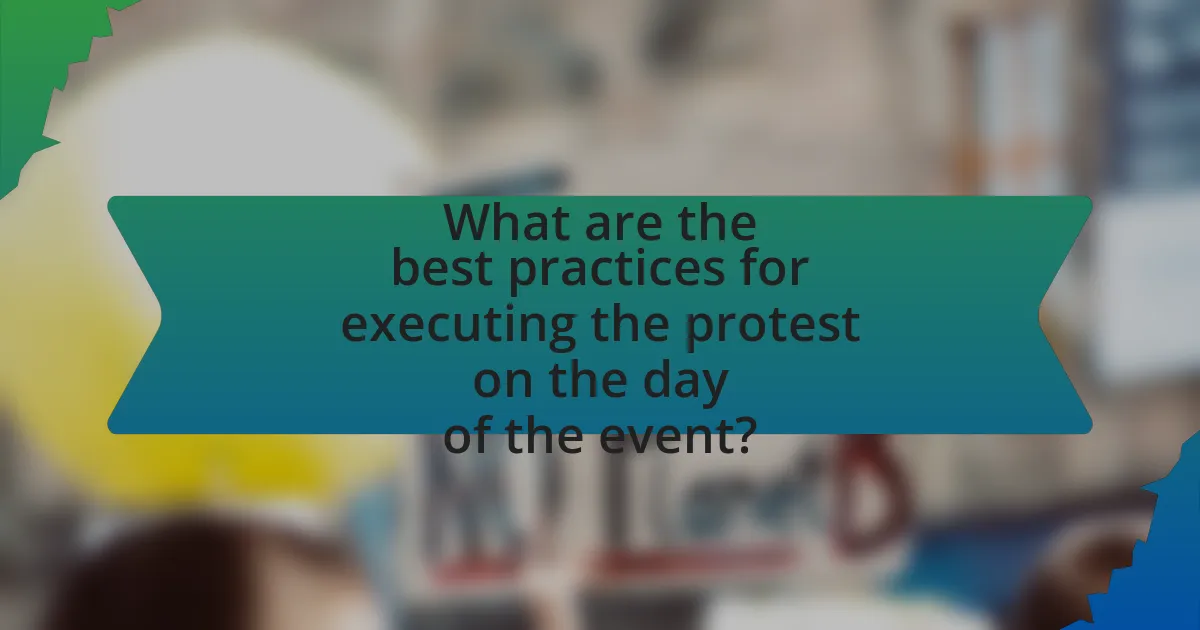
What are the best practices for executing the protest on the day of the event?
The best practices for executing a protest on the day of the event include ensuring clear communication among participants, maintaining a peaceful demeanor, and adhering to local laws and regulations. Clear communication is vital for coordinating actions and addressing any issues that arise during the protest. Maintaining a peaceful demeanor helps to convey the message effectively and reduces the likelihood of confrontations with law enforcement or counter-protesters. Adhering to local laws, such as obtaining necessary permits and following designated routes, is essential to avoid legal repercussions and ensure the protest can proceed smoothly. These practices are supported by historical examples, such as the Civil Rights Movement, where organized, peaceful protests led to significant social change.
How can you coordinate activities effectively on the day of the protest?
To coordinate activities effectively on the day of the protest, establish clear roles and responsibilities among participants. Assign specific tasks such as crowd management, communication, and logistics to designated individuals or teams to ensure smooth operations. For instance, having a designated spokesperson can facilitate communication with the media and authorities, while a logistics team can manage supplies and equipment. Additionally, using walkie-talkies or group messaging apps can enhance real-time communication, allowing for quick adjustments as needed. Historical examples, such as the Women’s March in 2017, demonstrate that organized roles and effective communication contribute significantly to the success of large-scale protests.
What roles should volunteers and organizers take on during the event?
Volunteers and organizers should take on specific roles to ensure the success of a student protest. Organizers are responsible for planning logistics, coordinating schedules, and managing communication among participants. They also handle permits and liaise with authorities to ensure compliance with regulations. Volunteers, on the other hand, assist with crowd management, distribute materials, and provide support to participants, ensuring that the event runs smoothly. Research indicates that effective role delegation enhances event efficiency and participant engagement, as seen in successful protests like the 2017 Women’s March, where clear roles contributed to a well-organized turnout.
How can you manage the flow of participants and activities?
To manage the flow of participants and activities during a student protest, implement a structured plan that includes designated entry and exit points, clear signage, and a schedule of activities. This approach ensures that participants can navigate the event efficiently, reducing congestion and confusion. For instance, using a map to outline specific areas for speeches, performances, and discussions can help maintain order and facilitate movement. Additionally, assigning volunteers to guide participants and monitor crowd density can enhance safety and organization. Studies show that well-organized events with clear pathways and schedules lead to higher participant satisfaction and engagement, as evidenced by successful protests like the March for Our Lives, which utilized similar strategies to manage large crowds effectively.
What techniques can be used to maintain momentum throughout the protest?
To maintain momentum throughout a protest, organizers can utilize techniques such as strategic planning, consistent communication, and engaging activities. Strategic planning involves setting clear goals and timelines, which helps participants stay focused and motivated. Consistent communication through social media updates and group messaging keeps participants informed and connected, fostering a sense of community. Engaging activities, such as speeches, performances, or interactive demonstrations, can energize the crowd and sustain enthusiasm. Historical examples, such as the Civil Rights Movement, demonstrate that well-organized protests with clear objectives and active participant engagement can effectively maintain momentum and drive change.
How can you adapt to unexpected challenges during the event?
To adapt to unexpected challenges during the event, maintain flexibility and have contingency plans in place. This involves preparing alternative strategies for various scenarios, such as changes in weather, venue issues, or disruptions from counter-protests. For instance, having a backup location or a communication plan to quickly inform participants of changes can mitigate potential disruptions. Historical examples, such as the 2011 Occupy Wall Street movement, demonstrate that adaptability in response to unforeseen circumstances can sustain momentum and engagement among participants.
What methods can be used to keep energy levels high among participants?
To keep energy levels high among participants, organizers can implement strategies such as regular breaks, engaging activities, and energizing refreshments. Regular breaks allow participants to recharge physically and mentally, which is essential for maintaining focus and enthusiasm. Engaging activities, such as interactive discussions or performances, can stimulate interest and participation, fostering a lively atmosphere. Additionally, providing energizing refreshments, like healthy snacks and hydration options, supports physical stamina and keeps participants alert. Research indicates that proper nutrition and hydration significantly impact cognitive function and energy levels, reinforcing the effectiveness of these methods in sustaining participant engagement during events like protests.
What follow-up actions are essential after the protest concludes?
Essential follow-up actions after a protest concludes include debriefing participants, documenting the event, and engaging with stakeholders. Debriefing allows organizers to gather feedback and assess the effectiveness of the protest, which is crucial for future planning. Documenting the event, including capturing photos, videos, and written accounts, provides a record that can be used for advocacy and accountability. Engaging with stakeholders, such as school administration or local authorities, fosters dialogue and can lead to meaningful changes based on the protest’s objectives. These actions ensure that the momentum generated by the protest is not lost and can lead to tangible outcomes.
How can you evaluate the success of the protest?
To evaluate the success of a protest, one must assess the achievement of its stated goals and objectives. This includes measuring changes in public awareness, policy shifts, or responses from authorities that align with the protest’s demands. For instance, if a protest aimed to raise awareness about climate change and resulted in increased media coverage and subsequent policy discussions, it can be deemed successful. Additionally, participant engagement levels, such as the number of attendees and their commitment to follow-up actions, serve as indicators of success. Historical examples, such as the Women’s March in 2017, which mobilized millions and influenced political discourse, further illustrate how tangible outcomes and sustained activism can signify a successful protest.
What steps should be taken to maintain engagement with participants post-protest?
To maintain engagement with participants post-protest, organizers should implement follow-up communication strategies, such as sending newsletters or updates about ongoing initiatives. This approach keeps participants informed and connected to the cause, fostering a sense of community and continued involvement. Research indicates that consistent communication can increase participant retention and activism; for example, a study by the Pew Research Center found that 70% of activists reported feeling more engaged when they received regular updates about their cause. Additionally, creating opportunities for participants to engage in further actions, such as community meetings or volunteer opportunities, reinforces their commitment and encourages sustained activism.
What are some common pitfalls to avoid when organizing a student protest?
Common pitfalls to avoid when organizing a student protest include lack of clear objectives, inadequate communication, and failure to secure necessary permits. Clear objectives are essential for guiding the protest’s message and goals; without them, participants may become disorganized and unfocused. Inadequate communication can lead to misunderstandings among organizers and participants, resulting in a lack of cohesion during the event. Additionally, failing to secure necessary permits can result in legal issues, potentially leading to the protest being shut down or participants facing penalties. These pitfalls can undermine the effectiveness and impact of the protest.
How can poor communication impact the protest’s success?
Poor communication can significantly hinder a protest’s success by creating confusion among participants and diminishing the clarity of the protest’s goals. When organizers fail to convey essential information, such as the time, location, and purpose of the protest, participants may arrive unprepared or at the wrong place, leading to low turnout and disorganization. Historical examples, such as the 2011 Occupy Wall Street movement, illustrate that unclear messaging can result in fragmented efforts and a lack of cohesive action, ultimately undermining the protest’s impact. Effective communication is crucial for mobilizing support, ensuring that all participants are aligned with the protest’s objectives, and fostering a unified front that can attract media attention and public support.
What are the risks of not having a clear plan or goals?
Not having a clear plan or goals significantly increases the risk of failure in organizing a successful student protest. Without defined objectives, participants may lack direction, leading to disorganization and ineffective communication. This disarray can result in low turnout, as potential supporters may be uncertain about the protest’s purpose or message. Additionally, unclear goals can hinder the ability to measure success, making it difficult to assess the impact of the protest or to strategize for future actions. Historical examples, such as the 2011 Occupy Wall Street movement, illustrate that protests lacking clear objectives often struggle to maintain momentum and public support, ultimately diminishing their effectiveness.
